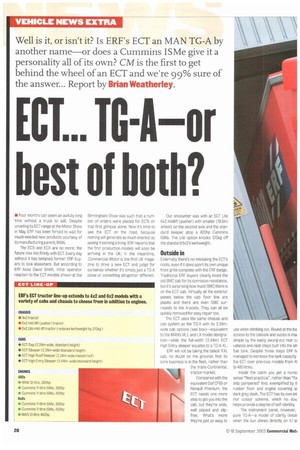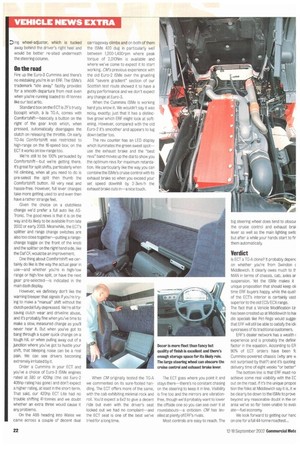ECI.. IG-A or best of both?
Page 20

Page 21

Page 22

If you've noticed an error in this article please click here to report it so we can fix it.
• Four months can seem an awfully long time without a truck to sell. Despite unveiling its ECT range at the Motor Show in May, ERF has been forced to wal for much-needed new products courtesy of its manufacturing parent, MAN.
The ECS and ECX are no more; the future now lies firmly with ECT. Every day without it has tempted former ERF buyers to look elsewhere. But according to ERF boss David Smith, initial operator reaction to the ECT models shown at the
Birmingham Show was such that a number of orders were placed for ECTs on that first glimpse alone. Now it's time to see the ECT on the road, because nothing will generate as much interest as seeing it earning a living. ERF reports that the first production models will soon be arriving in the UK; in the meantime, Commercial Motor is the first UK magazine to drive a new ECT and judge for ourselves whether it's simply just a TO-A clone or something altogether different. Our encounter was with an ECT Lite 6x2 midlift (pusher) with smaller (19.5in) wheels an the second axle and the standard sleeper atop a 420hp Cummins ISMe. The Lite option knocks 370kg off the standard 8x2's kerbweight.
Outside in
Externally there's no mistaking the ECT's roots, even if it does sport its own unique front grille complete with the ERF badge. Traditional ERF buyers clearly loved the old SMC cab for its corrosion resistance, but it's surprising how much SMC there is on the ECT cab. Virtually all the exterior panels below the cab floor line are plastic and there are even SMC surrounds to the A-posts. They can all be quickly removed for easy repair too.
The ECT uses the same chassis and cab system as the TG-A with its 2.24mwide cab options (see box )—equivalent to the MAN's M, L and LX model designation—while the full-width (2.44m) ECT High Entry sleeper equates to a TO-A XL.
ERF will not be taking the tallest XXL cab, no doubt on the grounds that its core business is in the fleet, rather than the trans-Continental, tractor market.
Compared with the equivalent Daf CF85 or Renault Premium, the ECT needs one more step to get you into the cab, but they're wide, well placed and slipfree. What's more they're just as easy to
use when climbing out. Round at the ba access to the catwalk and suzies is mat simple by the easily swung-out rear c■ valance and neat steps built into the all fuel tank. Despite those steps ERF 111 managed to increase the tank capacity the ECT over previous models from 41 to 480 litres.
Inside the cabin you get a no-no sense "fleet practical', rather than "fla ship pampered feel, exemplified by tl rubber floor and engine covering at dark grey dash. The ECT has its awn int nor colour scheme, which no dou helps provide a degree of self-identity. The instrument panel, however, pure TO-A--a model of clarity (exce when the sun shines directly on it) al MAN'S designers deserve praise for resisting the urge to curve the dash around the driver a la Scania.
One thing you won't find in the MAN is the Cummins Celect data display that sits in the DIN opening to the left of the driver's leg. We'd prefer it to switch places with the radio, which is in the headlining above the driver's head—not least as the radio would end up being easier to adjust as a result,
Once you've threaded your way past the gear lever (the air dump on the seat helps) it's easy enough to get across to the bunk. This being a standard-height sleeper you're not exactly overwhelmed by storage space. There's some in the headlining and door pockets, but the cen tre of the under-bunk area is taken up by a neat slide-out cool box. That leaves two lockers on either side with one (on the left) accessible from the cab while the ore on the right is the traditional "wet" locker with access from outside. If you want more space you'll have to order the high-roof option.
When we first teStecl the TG-4 we remarked on how simple the driver's seat was to adjust with the minimum of control buttons. EDT obviously uses the same supplier. Not only is it extremely supportive but you can also adapt it to individual tastes in a matter of seconds.
We're less impressed by the steer
D ing wheel-adjuster, which is tucked away behind the driver's right heel and would be better re-sited underneath the steering column.
On the road Fire 6p the EJro-3 Cummins and there's no mistaking you're in an ERF. The ISMe's trademark "idle away" facility provides for a smooth departure from rest even when you're running loaded to 41 tonnes like our test artic.
Standard box on the ECT is 7F's trusty Ecosplit which, a la TG-A, comes with Comfortshift—basically a button on the right of the gear knob which, when pressed, automatically disengages the clutch on releasing the throttle. On early TO-As Comfortshift was restricted to high-range on the 16-speed box; on the ECT it works on low-range too.
Were still to be 100% persuaded by Comfortshift—but we're getting there. Its great for split shifts, particularly when hill climbing, when all you need to do is pre-select the split then thumb the Comfortshift button. All very neat and hassle-free. However, full lever changes take more getting used to and even then have a rather strange feel.
Given the choice on a clutchless change we'd prefer a full auto like ASIronic. The good news is that it is on the way and its likely to be available from late 2002 or early 2003. Meanwhile, the ECT's splitter and range change switches are also too close together—putting a rangechange toggle on the front of the knob and the splitter on the right hand side, like the Oaf CF, would be an improvement.
One thing about Comfortshift we certainly do like is the way the actual gear in use—and whether you're in high/low range or high/low split, or have the next gear pre-selected—is indicated in the main dash display.
However, we definitely don't like the warning bleeper that signals if you're trying to make a "manual" shift without the clutch pedal fully depressed. We're all for saving clutch wear and driveline abuse, and it's probably fine when you've time to make a slow, measured change as you'll never hear it. But when you've got to bang through a super quick change on a tough hill, or when pulling away out of a junction where you've got to hustle your shift, that bleeping noise can be a real pain. We can see drivers becoming extremely irritated by it.
Order a Cummins in your ECT and you've a choice of Euro-3 ISMe engines rated at 380 or 420hp (the old Euro-2 405hp rating has gone) and don't expect a higher rating, at least in the short-term. That said, our 420hp ECT Lite had no trouble shifting 41-tonnes and we doubt whether an extra three would cause it any problems.
On the A55 heading into Wales we came across a couple of decent dual carriageway climbs and on both of them the ISMe 420 dug in particularly well between 1,200-1,400rpm where peak torque of 2,010Nm is available and where we've come to expect it to star: working. CM's previous experience with the old Euro-2 ISMe over the gruelling A68 "severe gradient" section of our Scottish test route showed it to have a gutsy performance and we don't expect any change at Euro-3.
When the Cummins ISMe is working hard you know it. We wouldn't say it was noisy, exactly; just that it has a distinctive growl which ERF might look at softening. However, compared with the old Euro-2 it's smoother and appears to lug down better too.
The rev counter has an LED display which illuminates the green sweet spot— use the exhaust brake and the "best revs" band moves up the dial to show you the optimum revs for maximum retardation. We particularly like the way you can combine the ISMe's cruise control with its exhaust brake so when you exceed your set speed downhill by 2-3km/h the exhaust brake cuts in—a nice touch.
When CM originally tested the TG-A we commented on its sure-footed handling. The ECT offers more of the same, with the cab exhibiting minimal rock and roll. You'd expect a 6x2 to give a decent ride but even with the driver's seat locked out we had no complaint—and the ECT seat is one of the best we've tried for a long time. the EC( goes where you point it and stays there—there's no constant chasing on the steering to keep it in line. Visibility is fine too and the mirrors are vibrationfree, though we'd probably want to lower the offside one so you can see over it at roundabouts—a criticism CM has levelled at plenty of ERF's rivals.
Most controls are easy to reach. The big steering wheel does tend to obscur the cruise control and exhaust bral lever as well as the main lighting switc but after a while your hands start to fir them automatically.
Verdict
Is ECT a TG-A clone? it probably depenc on whether you're from Swindon Middlewich. It clearly owes much to tt MAN in terms of chassis, cab, axles ar suspension. Yet the ISMe makes it unique proposition that should keep oh time ERR buyers happy, while the quail' of the ECT's interior is certainly vast superior to the old ECS/ECX range.
The fact that a Vehicle Modification Or has been created up at Middlewich to hai die specials like Pet-Regs would sugge: that ERR will still be able to satisfy the idir syncrasies of its traditional customers.
EFIF's dealer network has a wealth ( experience and is probably the definir factor in the equation. According to ER 90% of ECT orders have been ft Cummins-powered chassis (why are e. not surprised by that?) and it's quoting delivery time of eight weeks "or better'
The bottom line is that ERR must no achieve some real visibility with the EC out on the road. If it's the unique propos tion the folks at Middlewich say it is, it w be clearly be down to the ISMe to prove beyond any reasonable doubt in the on area we've so far been unable to evali ate—fuel economy.
We look forward to getting our hanc on one for a full 44-tonne roacttest...




























































































































































